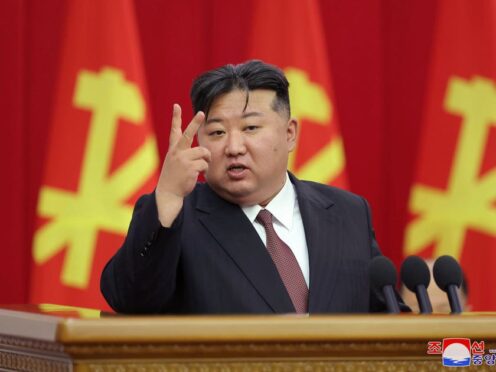
North Korea said on Tuesday it had test-fired a new tactical ballistic missile capable of carrying “a super-large warhead”, a claim quickly disputed by South Korean officials and experts who speculate the North likely fabricated a successful test to conceal a botched launch.
It is the second time that South Korea has questioned North Korea’s claim on the development of new weapons in recent days, as the rivals are locked in heightened animosities over the North’s testing activities.
The North’s official Korean Central News Agency said that Monday’s test involved the Hwasongpho-11 Da-4.5 missile, which can carry a 4.5 tonne-class warhead.

It said the test was meant to verify the weapon’s flight stability and hit accuracy at the maximum range of 500 kilometres (310 miles) and the minimum range of 90 kilometres (55 miles).
The test apparently refers to the two ballistic missile launches that South Korea said North Korea performed Monday.
Joint chiefs of staff spokesman Lee Sung Joon said at a briefing later Tuesday that the second North Korean missile was found to have fallen on an uninhabited area near Pyongyang, the North’s capital.
He said he could find few previous test-launches by North Korea that have aimed at ground target sites.
“Regarding the North Korean assessment, we’re weighing a possibility of deception,” Mr Lee said.
The South Korean military has said the second North Korean missile possibly travelled abnormally during the initial stage of its flight.
It said if the missile exploded, its debris would likely have scattered on the ground.
The KCNA dispatch didn’t say from where it launched the new missile and where it landed.

Unlike previous weapons tests, North Korea also didn’t publicise any photos of Monday’s test.
The fact that it tested both the missile’s maximum and minimum ranges suggested North Korea performed two launches.
KCNA, citing North Korea’s Missile Administration, reported that North Korea will test-fire the missile again later in July to verify the performances of its simulated warhead at the medium range of 250 kilometres (155 miles).
Some experts say test-firing missiles at ground targets could be related to efforts to test how powerful warheads are to destroy underground bunkers and structures.
But Shin Jongwoo, a Seoul-based military expert, said the lack of any photos on the launches means it is highly likely the North is trying to deceive the outsiders to cover up Monday’s failed launches.
He said North Korea likely launched an existing missile on Monday, not the new missile at it claimed.
Yang Uk, an analyst at Asan Institute for Policy Studies, said that Monday’s tests reflected North Korea’s push to acquire a variety of conventional weapons.
But he also said if North Korea truly succeeded in hitting a ground target, it probably would have already published related images to brag about its achievements as it has done in the past.

Since 2022, North Korea has sharply accelerated weapons testing activities to enlarge its nuclear arsenal.
The North Korea-claimed ranges of the newly tested missile imply it targets South Korea.
Experts say North Korea would ultimately want to use an expanded weapons arsenal to increase its leverage in future diplomacy with the US.
On June 26, North Korea launched what it called a new multiwarhead missile in the first known test of a developmental weapon aimed at penetrating its rivals’ missile defences.
North Korea said the launch was successful, but South Korea dismissed the North’s claim as deception to cover up a failed launch.
South Korea said the weapon blew up, sending debris in the waters off the North’s east coast.

Enjoy the convenience of having The Sunday Post delivered as a digital ePaper straight to your smartphone, tablet or computer.
Subscribe for only £5.49 a month and enjoy all the benefits of the printed paper as a digital replica.
Subscribe